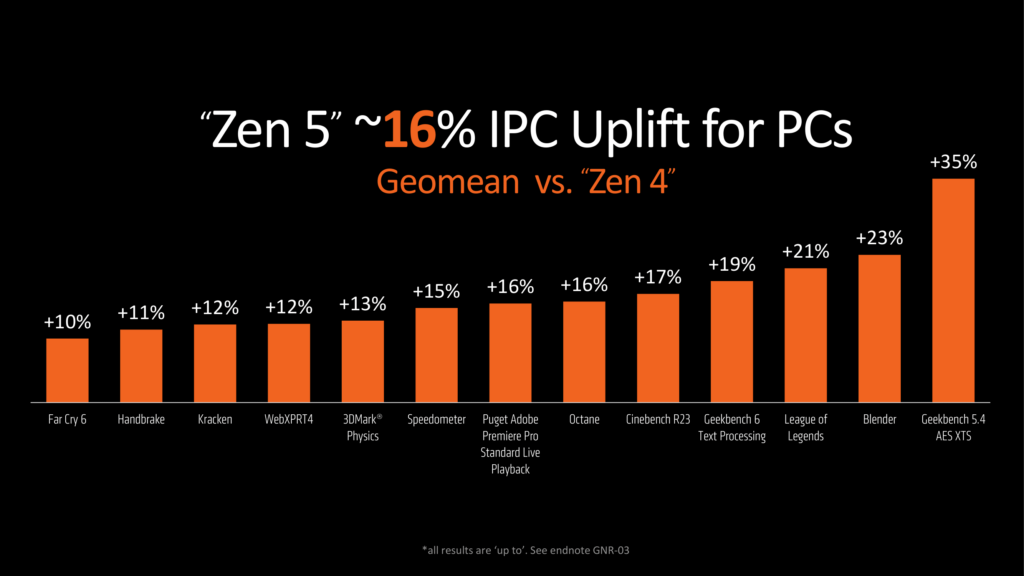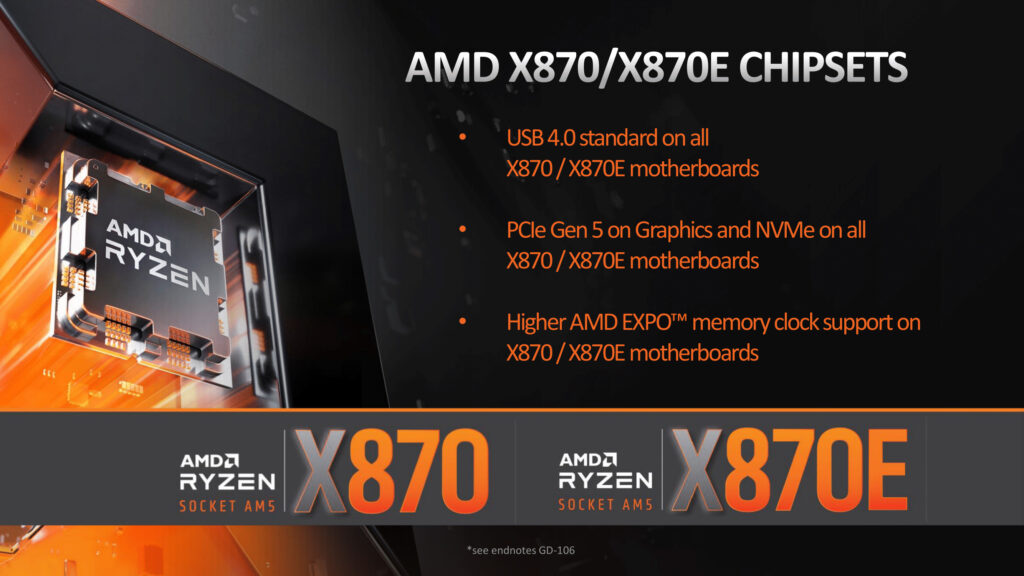- AMD gave us our first look at the Ryzen 9000 Series CPUs and Zen 5 microarchitecture at the COMPUTEX Keynote held on 5th June 2024.
- Base Clocks have been reduced, with Turbo Clocks remaining the same for the most part, which has led to a significant reduction in the CPUs’ TDPs.
- Two new motherboards, the X870 & X870E, have also been uncloaked as part of AMD’s 800-Series Chipsets.
While it may still feel like AMD just released the Ryzen 7000 Series Processors based on the brand new AM5 CPU Socket and the Zen 4 platform, the truth is, it’s been more than nine months.
What does that mean for you and me? Well, if you weren’t content with the performance of the Ryzen 7000 ‘Raphael’ CPUs, you’re in luck.
AMD has finally taken off the covers with regards to its Ryzen 9000 Series Processors based on the redesigned Zen 5 microarchitecture, but of course, the same AM5 socket thanks to AMD’s commitment to upholding their sockets’ longevity.
We’re looking at noticeable improvements with regard to real-world performance and lowered power consumption/higher efficiency alongside a pair of new chipsets to begin with.
AMD Ryzen 9000 Series: Zen 5
Let’s discuss Zen 5.

For starters, AMD is touting an apparent increase of 16% when it comes to IPCs (Instructions Per Clock) for the Ryzen 9000 ‘Granite Ridge’ processors, which aligns with the rumours we’d talked about.
As far as other relevant architectural changes are concerned, Zen 5 claims to introduce an improved branch predictor, which should improve the accuracy and efficiency of the instruction cycles while reducing collective latency, theoretically speaking. Zen 5 is also said to offer higher throughput and a deeper window across its design for enhanced parallelism.
Moving on, AMD has doubled the L2 to L1 memory bandwidth and expanded their SIMD (Single Instruction Multiple Data) to a full 512-bit wide (from the preceding 256-bit SIMD) one for AVX-512 workloads.
Also, Zen 5 is being fabricated on a 4nm node from TSMC, a modest shrink from the 5nm TSMC nodes used for Zen 4, which should help achieve the acclaimed power efficiency figures.
Long story short, the introduction of Zen 5 should translate to noticeably improved performance for productivity workflows, especially those that utilize the AVX-512 instruction set.
Initial SKUs
Following their historical tradition, AMD has chosen to release four CPUs from the Ryzen 9000 Series for now, all of which are the ‘X’ SKUs, meaning that these four processors will come with unlocked multipliers for overclocking.
First off, the Ryzen 5 9600X starts as the cheapest Zen 5 option, followed by the Ryzen 7 9700X as the mid-tier CPU, and championed by the Ryzen 9 9900X and Ryzen 9 9950X as the flagship processors.
| Processor | Cores | Threads | Max Boost | Cache | TDP |
|---|---|---|---|---|---|
| AMD Ryzen 9 9950X | 16 | 32 | 5.7GHz | 80MB | 170W |
| AMD Ryzen 9 9900X | 12 | 24 | 5.6GHz | 76MB | 120W |
| AMD Ryzen 7 9700X | 8 | 16 | 5.5GHz | 40MB | 65W |
| AMD Ryzen 5 9600X | 6 | 12 | 5.4GHz | 38MB | 65W |
Moreover, we’re seeing reduced Base Frequencies for all four SKUs by a difference of about 200 MHz to 800 MHz, whereas Turbo Frequencies remain unchanged or slightly increased by 100 MHz at most.
However, the headlining feature for Zen 5 and Ryzen 9000 CPUs isn’t the clock speeds; it’s the power consumption figures.
TDPs for the Ryzen 5 9600X and Ryzen 7 9700X are down to just 65W from 105W, while the Ryzen 9 9900X and Ryzen 9 9950X see a reduction of 50W, i.e., a TDP of 120W, down from the 170W figure seen in their Zen 4/Ryzen 7000 counterparts.
New Chipsets
Needless to say, the Ryzen 9000 Series CPUs will be backwards compatible with AMD’s 600-Series Motherboards, but nevertheless, AMD has come up with two brand new 800-Series Chipsets, i.e., the X870 & X870E.
Firstly, a few of the hallmark features include USB 4.0 as standard on both motherboards along with PCIe 5.0 as well.

Secondly, the X870E motherboard will also have WiFi 7 integrated into the chipset instead of WiFi 6E with the 600-Series chipsets.
| Latest AM5 Chipsets | X870E | X870 |
|---|---|---|
| CPU PCIe (PCIe) | 5.0 | 5.0 |
| CPU PCIe (M.2 Slots) | At Least 1 PCIe 5.0 Slot | At Least 1 PCIe 5.0 Slot |
| Total CPU PCIe Lanes | 24 | 24 |
| Chipset PCIe Lanes (Max) | 4.0: 12, 3.0: 8 | 4.0: 8, 3.0: 4 |
| USB4 | Mandatory (Discrete, Consumes 4 Chipset PCIe 4.0 Lanes) | Mandatory (Discrete, Consumes 4 Chipset PCIe 4.0 Lanes) |
| SATA Ports (Max) | 8 | 4 |
| DDR5 Support | Quad Channel (128-bit bus) | Quad Channel (128-bit bus) |
| Wi-Fi | Wi-Fi 7 (Discrete) | Wi-Fi 7 (Discrete) |
| CPU Overclocking Support | Yes | Yes |
| Memory Overclocking Support | Yes | Yes |
| # of Chips | 2 | 1 |
| Silicon | ASMedia Promontory 21 | ASMedia Promontory 21 |
| Available | July 2024 | July 2024 |
Also, users can expect to see higher AMD EXPO/Overclocking Support on these two chipsets, i.e., base speeds for DDR5 RAM should see a slight boost to 5600 MHz, up from 5200 MHz with Zen 4/Ryzen 7000 Series. It should be noted that AMD will not be releasing the 800-series motherboards alongside the new CPUs; the boards will launch a month later.
What About Gaming?
AMD itself confirmed that as far as gaming performance is concerned, the initial ‘X’ SKUs of the Ryzen 9000 Series will be unable to outperform the ‘X3D’ SKUs from the Ryzen 7000 lineup that are based on AMD’s revolutionary 3D V-Cache architecture.
Gaming enthusiasts will have to wait until the last quarter of the year, at the very least, for the Zen 5 ‘X3D’ Processors that will most probably cement the newest Ryzen CPUs as the Best Gaming Processors.
Until then, if you’re more of a productive user, the Ryzen 9000 Series, complete with its Zen 5 microarchitecture and revamped 800-Series chipsets, seems to pose a compelling bargain, especially for people who are looking to upgrade from their older Ryzen 3000 ‘Matisse’ or Ryzen 5000 ‘Vermeer’ systems.
So When Are We Getting It? And How Much?
Prospective buyers can expect to see the embargo lifted on the 31st of July, so the Ryzen 9000 Series CPUs should start flooding the market within the first two weeks of August 2024.
As far as MSRPs are concerned, if we look at AMD’s historical pricing conventions, the Ryzen 5 9600X will be available for somewhere around $280-320, ranging up to $580-620 for the best-in-class Ryzen 9 9950X.
Nonetheless, there’s only a month and then some to go until the actual release of the Ryzen 9000 Series. Till then, we suggest you get ready to make a dent in your wallet.
Thank you! Please share your positive feedback. 🔋
How could we improve this post? Please Help us. 😔
[Wiki Editor]
Ali Rashid Khan is an avid gamer, hardware enthusiast, photographer, and devoted litterateur with a period of experience spanning more than 14 years. Sporting a specialization with regards to the latest tech in flagship phones, gaming laptops, and top-of-the-line PCs, Ali is known for consistently presenting the most detailed objective perspective on all types of gaming products, ranging from the Best Motherboards, CPU Coolers, RAM kits, GPUs, and PSUs amongst numerous other peripherals. When he’s not busy writing, you’ll find Ali meddling with mechanical keyboards, indulging in vehicular racing, or professionally competing worldwide with fellow mind-sport athletes in Scrabble at an international level. Currently speaking, Ali has completed his A-Level GCEs with plans to go into either Allopathic Medicine or Business Studies, or who knows, perhaps a full-time dedicated technological journalist.
Get In Touch: alirashid@tech4gamers.com




